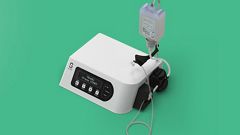
Dominar la comodidad de la aplicación. Hueso adherente directamente del blíster.
cerabone® plus es una combinación del material de injerto óseo bovino consolidado cerabone® e hialuronato de sodio. Al entrar en contacto con solución salina o sangre, forma un material óseo adherente, lo que permite una excelente comodidad de manipulación al facilitar tanto una fácil absorción como la administración en el lugar de aplicación.
Características y ventajas
Gracias a la gran capacidad absorbente del hialuronato, cerabone® plus, al hidratarse, forma una masa conectada y maleable que proporciona una aplicación más fácil en comparación con los injertos óseos convencionales particulados. cerabone® plus permite una fácil captación, una aplicación precisa de las partículas, así como un relleno eficaz y fácil contorneado de los defectos.

El ácido hialurónico es capaz de incorporar un volumen de líquido 1000 veces mayor que la molécula en sí. Es altamente higroscópico y biodegradable, y se descompondrá rápidamente en las primeras fases de la cicatrización.

El componente mineral óseo (cerabone®) muestra una estructura ósea similar a la humana con una red de poros tridimensional y una superficie rugosa. La estructura osteoconductora promueve la adhesión e invasión de células formadoras de hueso, lo cual resulta en una integración completa de los gránulos en la matriz ósea recién formada.
Utilizando únicamente calor y agua, el proceso de calentamiento a 1200 °C de cerabone® elimina todo componente orgánico y da lugar a un mineral óseo natural puro. La radiación gamma garantiza la esterilidad final de cerabone® plus.
Con una degradación limitada, cerabone® plus proporciona al lugar aumentado un soporte estructural predecible y viable, lo cual es especialmente ventajoso para el soporte de los tejidos blandos en la región estética, para la preservación de la forma de la cresta y para proteger el hueso autólogo o alogénico frente a la reabsorción.
*cerabone® plus ya está disponible en Suiza, Alemania, países nórdicos y Chile.
Folletos y vídeos
¿Buscas más información? Lo encontrarás en el Centro de descargas.













